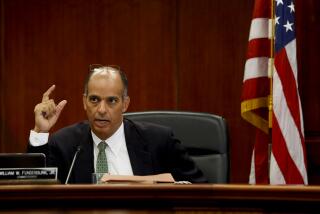Wright Partner Defends Oil Deal, Assails Panel Counsel
- Share via
FT. WORTH — House Speaker Jim Wright’s business partner said Friday that an oil deal under scrutiny by the House Ethics Committee was legitimate, despite implications of misconduct because $341,000 was made in a single day on what turned out to be a dry well.
George A. Mallick Jr., a Ft. Worth millionaire and longtime friend of the Speaker, divulged for the first time Friday his version of the events that led to the sale of a share of an oil well to a German investment company, Union Rheinische Petroleum Inc.--a transaction that is now a focal point of the investigation by the committee into the financial affairs of the Speaker.
And, in so doing, Mallick blasted the report prepared by Ethics Committee special counsel Richard J. Phelan, accusing him of selectively using information about the oil deal to cast it in its worst possible light.
Says Phelan Got Data
He said Phelan had been provided with documentation about the legitimacy of the deal but had failed to include the material in his report to the Ethics Committee.
“Phelan’s got those papers,” he said. “This is just how he wants it to look.”
At issue in this latest controversy involving the embattled Wright is a series of events in which Mallick sought to carry out one last deal for Mallightco Inc.--”to bet the farm,” as he told the committee--after the Speaker created a blind trust for his assets in October, 1987.
Wright owned a half interest in Mallightco and instructed Mallick to sell his share of the corporation.
Largely as a result of the windfall from the oil deal, Wright eventually received $350,000 when his share of Mallightco was sold.
According to the report prepared by Phelan, Mallick and his son, Michael, invested $9,120 in the well on May 10, then turned around and sold the German firm a part of that share in a complicated loan transaction for $440,000 on the same day, netting Mallightco a profit of $341,000 after expenses were deducted.
The case is further complicated by the fact that both deals were set up by the same man, M. D. (Doug) Jaffe Jr., a 38-year-old multimillionaire financier from San Antonio.
Mallick conceded that, with no further explanation, the huge profit had the look of wrongdoing about it, especially because the well was eventually capped. But he said the more complete story made what happened far less suspicious.
According to Mallick, he began looking for a deal to greatly enhance the value of Mallightco soon after Wright asked him to prudently sell off his share of the corporation. He said he called a number of oilmen, telling them he wanted to invest $100,000 of Mallightco’s $150,000 in assets, with the stipulation that the deal needed to be done quickly.
He said that one of the men he called was longtime friend M. D. (Morris) Jaffe Sr., Douglas’ father and a major contributor to Democratic Party candidates.
“He told me he had a home run going,” Mallick said. He said Jaffe told him he had invested in an oil drilling venture in East Texas, on Lake Sabine at the Louisiana state line. But he said his son was the biggest investor, with a 50% stake in the deal.
Son Struck a Deal
Mallick said his son, Michael, and Douglas Jaffe eventually struck a deal in which $90,000 would eventually be invested for a 4% share of the well. He said the letter of agreement was signed on Jan. 12, 1988, but that no money changed hands.
It is at this point that the Phelan report and Mallick begin to diverge in what happened.
On March 4, drilling began on the well, and by April 9 the hole had been bored to a depth of 11,560 feet. Mallick said the initial tests looked very promising. That contention has been supported by both the engineering firm overseeing the drilling, Brammer Engineering Inc., and the company that sank the well, Dean Shank Drilling Co.
“Everyone was really getting excited about the well,” Mallick said.
According to the Ethics Committee report, it was clearly evident by late April that the well was not going to be a gusher.
Mallick disputes that, saying that workers were still “swabbing,” or cleaning out, the well through May and that there was every hope that it would be productive, as were three adjacent wells owned by Exxon Corp.
He said Douglas Jaffe, on the basis of the well’s promise, approached him in mid-April and asked if he would be interested in selling his 4% share to Union Rheinische, a company that Jaffe had advised on financial matters for a number of years.
Mallick said he decided to cover himself at both ends of the deal, selling a part of Mallightco’s share to the German company but keeping a 1.5% share for himself. He said a deal was struck in which Union Rheinische would pay $440,000 but Mallick would pay back $90,000 to cover costs accrued up to then.
He said also that the appearance of having made a large sum of money in one day was simply a matter of bookkeeping. In order to divest Mallightco of a part of the interest in the oil well, it first had to be recorded that the corporation was an investor. Hence, he said, both transactions took place on the same day.
Mallick said more evidence to rebut the report was that an additional $2 million was spent on a second well at the site after the original hole developed problems.
“They didn’t abandon the well until September,” he said.
“All this will be put to rest next week,” Mallick said, when Ethics Committee members travel to San Antonio to take depositions from both Jaffes.
“This was tame,” Mallick said. “I’ve seen much wilder stuff that this.”
More to Read
Get the L.A. Times Politics newsletter
Deeply reported insights into legislation, politics and policy from Sacramento, Washington and beyond. In your inbox three times per week.
You may occasionally receive promotional content from the Los Angeles Times.










